Emergency Showers and Eyewash Stations
On this page
- Why are emergency showers or eyewash stations important?
- What does the law say?
- What is considered to be a 'flushing fluid'?
- How long should the contact area be rinsed or flushed?
- What type of equipment should be installed?
- What specifications should the equipment meet?
- Where should the emergency equipment be located?
- What temperature should the water be?
- What are examples of areas that may require this equipment?
- What other factors should I consider when selecting and using this type of emergency equipment?
- Are there any limitations to should be aware of?
- When should equipment be inspected and maintained?
- What type of training should the workers receive?
Why are emergency showers or eyewash stations important?
Back to topThe first 10 to 15 seconds after exposure to a hazardous product, especially a corrosive product, are critical. Delaying treatment, even for a few seconds, may contribute to a serious injury.
Emergency showers and eyewash stations provide on-the-spot decontamination. They allow workers to flush away hazardous products that can cause injury.
Incidental exposures can still occur even with good engineering controls and safety precautions. As a result, it is essential to look beyond the use of safe work procedures or personal protective equipment. Emergency showers and eyewash stations are necessary backups to minimize the effects of exposure to chemicals.
Emergency showers can also be used effectively in extinguishing clothing fires or for flushing contaminants off clothing.
What does the law say?
Back to topConsult your local occupational health and safety agency in your jurisdiction and check relevant legislation for any requirements to install this equipment. Currently, there is no Canadian standard for the design or placement of eyewash stations or emergency showers. As a result, the American National Standards Institute (ANSI) Standard Z358.1-2014 (R2020) "Emergency Eyewash and Shower Equipment" is generally used as a guide. Always follow the manufacturer's instructions for installing the unit.
Note: since there is no Canadian standard for emergency showers and eyewash stations, the U.S. ANSI Standard Z358.1-2014 (R2020) was used in preparing this document.
What is considered to be a 'flushing fluid'?
Back to topThe ANSI standard defines "flushing fluid" as any potable (drinking) water, preserved water, preserved buffered saline solution or other medically acceptable solutions. Local laws may apply in some cases. This document will use the term "water" to mean any of these acceptable flushing fluids unless otherwise specified.
How long should the contact area be rinsed or flushed?
Back to top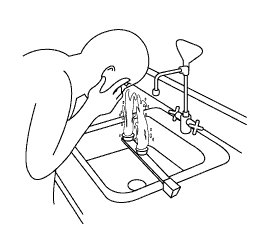
ANSI Z358.1-2014 (R2020) does not specify how long the affected body part should be rinsed. It does specify that the equipment installed according to the standard is capable of providing flushing liquid for a minimum of 15 minutes.
The safety data sheet (SDS) for the hazardous product should provide guidance on flushing in Section 4: First Aid Measures.
It is agreed that it is very important that water flushing start immediately following skin or eye contact with a chemical.
"First Aid Guidelines" are available from the American Heart Association and the American Red Cross. They state that it "can be beneficial to rinse eyes exposed to toxic chemicals immediately and with a copious amount of tap water for at least 15 minutes or until advanced medical care arrives. If tap water is not available, normal saline or another commercially available eye irrigation solution may be reasonable."
Always:
- Brush powdered chemicals off the skin with a gloved hand or piece of cloth.
- Remove all contaminated clothing from the victim, making sure you do not contaminate yourself in the process.
- Monitor for hypothermia when cooling large burns.
In all cases, if irritation persists, repeat the flushing procedure. It is important to get medical attention as soon as possible after first aid has been given. A physician familiar with procedures for treating chemical exposure to the eyes and body should be consulted.
What type of equipment should be installed?
Back to topEmergency showers are designed to flush the user's head and body. They should not be used to flush the user's eyes because the high rate or pressure of water flow could damage the eyes in some instances. Eyewash stations are designed to flush the eye and face area only. There are combination units available that contain both features: a shower and an eyewash.
The need for emergency showers or eyewash stations is based on the properties of the chemicals that workers use and the tasks that they do in the workplace. A job hazard analysis and risk assessment can provide an evaluation of the potential hazards of the job and the work areas. The selection of protection -- emergency shower, eyewash or both -- should match the hazard.
In some jobs or work areas, the effect of a hazard may be limited to the worker's face and eyes. Therefore, an eyewash station may be the appropriate device for worker protection. In other situations, the worker may risk part or full body contact with a chemical. In these areas, an emergency shower may be more appropriate.
A combination unit has the ability to flush any part of the body or all of the body. It is the most protective device and should be used wherever possible. This unit is also appropriate in work areas where detailed information about the hazards is lacking or where complex, hazardous operations involve many chemicals with different properties. A combination unit is useful in situations where there are difficulties handling a worker who may not be able to follow directions because of intense pain or shock from an injury.
What specifications should the equipment meet?
Back to topNote: All dimensions and measurements are taken from the American National Standards Institute (ANSI) standard Z358.1-2014 (R2020) "Emergency Eyewash and Shower Equipment." However, not all dimensions and measurements required by the ANSI standard are listed here.
Emergency Showers
The emergency shower should deliver a pattern of water with a diameter of at least 50.8 cm (20 inches) at 152.4 cm (60 inches). This diameter ensures that the water will come into contact with the entire body - not just the top of the person's head. ANSI also recommends the shower head be between 208.3 and 243.8 cm (82-96 inches) from the floor. The minimum flow should be 75.7 litres/minute (20 gallons/minute) for a minimum time of 15 minutes.
The shower should also be designed so that it can be activated in less than 1 second and it remains operational without the operator's hand on the valve (or lever, handle, etc.). This valve should not be more than 173.3 cm (69 inches) in height. If enclosures are used, ensure that there is an unobstructed area of 86.4 cm (34 inches) in diameter.
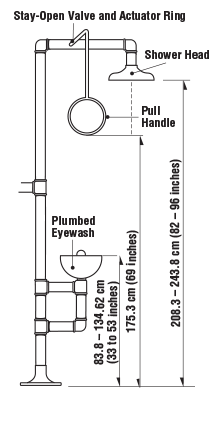
Eyewash and Eye/Face Wash Stations
Eyewash stations should be designed to deliver fluid to both eyes simultaneously at a volume flow rate of not less than 1.5 litres/minute (0.4 gallons/minute) for 15 minutes. The combination eye and face wash stations require 11.4 litres per minute (3.0 gallons per minute). However, in either case, the flow should not be at a velocity which may injure the eyes. The unit should be between 83.8 and 134.6 cm (33 to 53 inches) from the floor and a minimum of 15.3 cm (6 inches) from the wall or nearest obstruction.
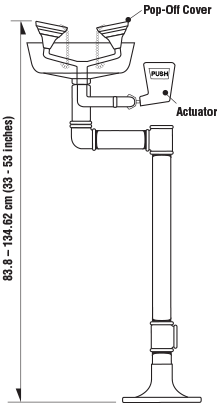
With an eye wash station, the user should be able to open their eyelids with their hands and still have their eyes in the liquid. In the case of the eye/face wash, the user should have enough room to allow the eyelids to be held open with the hands while the eyes and face are still in the stream. As with the shower, the unit should also be designed so that it can be activated in less than 1 second, and it remains operational without the operator's hand on the valve (or lever, handle, etc.) with the valve being located in an easily located place. Since the nozzles to eyewash stations typically need to be protected from airborne contaminants, the units are to be designed such that the removal of these covers should not require a separate motion by the user when the unit is activated.
Self-contained Eye/Face Washes
Install and maintain according to the manufacturer's instructions. Similar requirements apply as with the plumbed units regarding the unit's ability to provide flushing liquid for at least 15 minutes, accessible access, and to deliver tepid flushing fluid. Inspect the units regularly to ensure the bladder is not expired. Once activated, the bladders must be replaced.
Personal Wash Stations
Designed to deliver flushing fluid immediately, personal wash units can be used while transporting the person to the permanent eyewash station or medical facility. These stations do not replace the requirement to have a 15-minute supply eyewash station. The expiry date of the fluid should be printed permanently on the unit and inspected regularly. These personal wash units are single-use and cannot be refilled.
Drench Hoses
Drench hoses may be used to "spot" rinse an area when a full shower is not required, to assist a person when the person is unable to stand or is unconscious, or to wash under a piece of clothing before the clothing is removed. The ANSI standard states that a drench hose may be considered an eyewash or eye/face wash if the drench hose meets the performance requirements as listed in the standard.
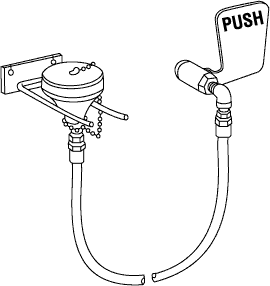
Combination Units
This name refers to equipment that shares a common plumbing fixture. Any of the fixtures such as shower, eyewash, eye/face wash or drench hose may be in this combination, but most commonly, it refers to a shower and an eye wash station. It is important that pressure and volume requirements for each piece of the unit (as described above) are in compliance with the code.
Where should the emergency equipment be located?
Back to topTo be effective, the equipment has to be accessible. ANSI recommends that a person be able to reach the equipment in 10 seconds. In practical terms, consider that the person who needs the equipment will be injured and may not have use of their vision. ANSI notes that the average person can walk 16 to 17 metres (55 feet) in 10 seconds, but this does not account for the physical and emotional state of the person in an emergency.
As such, the "10-second" rule may be modified depending on the potential effect of the chemical. Where a highly corrosive chemical is used, an emergency shower and eyewash station may be required to be closer to the workstation. Refer to your risk assessment and check with a professional with knowledge in this area. These units should be installed in such a way that they do not become contaminated by corrosive chemicals used nearby.
The location of each emergency shower or eyewash station should be identified with a highly visible sign. The sign should be in the form of a symbol that does not require workers to have language skills to understand it. The location should be well-lit.
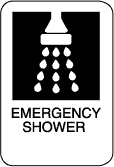

Other recommendations include that the emergency shower or eyewash station should:
- be located as close to the hazard as possible,
- not be separated by a partition from the hazardous work area,
- be on an unobstructed path between the workstation and the hazard (workers should not have to pass through doorways or weave through machinery or other obstacles to reach them),
- be located where workers can easily see them - preferably in a normal traffic pattern,
- be on the same floor as the hazard (no stairs to travel between the workstation and the emergency equipment),
- be located near an emergency exit where possible so that any responding emergency response personnel can reach the person easily,
- be located in an area where further contamination will not occur,
- provide a drainage system for the excess water (remember that the water may be considered hazardous waste, and special regulations may apply),
- not come into contact with any electrical equipment that may become a hazard when wet, and
- be protected from freezing when installing emergency equipment outdoors.
What temperature should the water be?
Back to topThe 2014 (R2020) ANSI standard recommends that the water should be "tepid" and defines this temperature as being between 16-38°C (60-100°F). Temperatures higher than 38°C (100°F) are harmful to the eyes and can enhance chemical interaction with the skin and eyes. Long flushing times with cold water (less than 16°C (60°F)) can cause hypothermia and may result in not rinsing or showering for the full recommended time (ANSI 2014). With thermal burns (injuries to the skin), the American Heart Association (2020) noted that thermal burns can be cooled with cool or cold potable water as soon as possible and for at least 10 minutes. (However, do not apply ice directly to the skin.) A temperature range for the water was not stated. Remember that any chemical splash should be rinsed for a minimum of 15 minutes, but rinsing time can be up to 60 minutes. The temperature of the water should be one that can be tolerated for the required length of time. Water that is too cold or too hot will inhibit workers from rinsing or showering as long as they should.
Install anti-scalding devices (temperature control valve or thermostatic tempering valve), constant flow meters, and other devices that will help maintain a constant temperature and flow rate. For cold or outdoor locations, emergency showers with heated plumbing are available. In hot climates, outdoor emergency showers should also have a tempering valve so that workers are not exposed to water that is too hot.
What are examples of areas that may require this equipment?
Back to topWork areas and operations that may require these devices include:
- Battery charging areas
- Laboratories
- Spraying operations
- High dust areas
- Dipping operations
- Product dispensing areas
What other factors should I consider when selecting and using this type of emergency equipment?
Back to topThe following factors should also be considered as part of a hazard analysis when decisions are being made about the selection and use of emergency showers, eyewash stations or combination units:
Potentially hazardous products in the immediate work area
All hazardous products need to be properly identified. A review of safety data sheets (SDSs) and labels can help to evaluate the hazard. To select the appropriate eyewash and shower equipment, you must know about the products you use and their potential risks.
Number of workers in an area with a hazardous product
More than one emergency shower or eyewash station may be required in an area where many workers use hazardous products. Evaluate how many workers are using the product, and provide more equipment where necessary to ensure each worker's protection.
Isolated workers
The installation of an audible or visual alarm can alert other workers when the emergency shower or eyewash station is being used. An alarm is especially important if only one worker happens to be working in that area. A person may need help in getting to the eyewash if temporarily blinded. Some companies connect valves electrically to warning lights or buzzers in central areas.
Comfort and warmth
Extra coveralls and foot covers should be stored near emergency showers. Contaminated clothes need to be removed from the injured person. Consider installing a privacy curtain (but remember to maintain the 'obstacle-free' diameter dimension as stated in the ANSI standard).
Quality of the Flushing Fluid
Changing the fluid in self-contained systems frequently and cleaning the units regularly can prevent the inadvertent use of contaminated fluid. Refer to the manufacturer's instructions for further details. Even in plumbed eyewash stations, the water may contain contaminants such as rust, scale and chemicals. Systems should be flushed and cleaned regularly.
Neutralized Solutions
It seems logical to neutralize exposure to acid with a base or vice versa. However, there are concerns that attempts to neutralize contamination of the skin or eyes could increase injury by causing:
- a delay in starting irrigation while first-aid providers search for special irrigating fluids,
- thermal burns from the heat given off when the two chemicals react, and
- additional injury due to contact with the neutralizing agent.
It is critical that flushing an exposure begins as quickly as possible. Water is readily available in most situations. Follow the chemical manufacturer’s instructions but do not delay treatment to search for a specific solution.
More information about first aid for chemical exposures is available in the OSH Answers First Aid for Chemical Exposures.
Are there any limitations to should be aware of?
Back to topPlumbed Emergency Showers and Eyewash Stations
Studies have shown that despite a general minimum of 15-minute flushing time being recommended, users usually only flush exposed body parts for five minutes or less. The reasons were always related to the extreme discomfort users experienced using cold water. In cold climates, the water temperature in indoor plumbed systems can be in the 2-7°C (35-45°F) range.
Be sure to maintain the equipment and provide tepid water for flushing. ANSI suggests a weekly activation to help reduce sediment and stagnant water issues.
Portable, Self-Contained Eyewash Stations
Portable, self-contained eyewash stations have a limited amount of fluid. As a result, maintenance is critical to ensure that units are fully charged at all times.
These eyewash stations also require ongoing maintenance of the flushing solution. The agents used to control bacterial growth are effective for certain limited periods of time. Also, small amoebae capable of causing serious eye infections have been found in portable and stationary eyewash stations. Consequently, it is important to monitor the shelf life of the solution and replace the solution when it has expired.
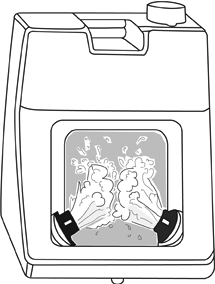
Eyewash Bottles
Eyewash bottles or personal eyewash units supplement plumbed and self-contained stations but in no way can replace them. They are portable and permit immediate flushing of contaminants or small particles. However, eyewash bottles are very difficult for the user to handle, especially when alone and when both eyes have been exposed (e.g., holding the eyelids open while handling the unit is awkward). Also, one bottle cannot flush both eyes simultaneously. Since the fluid supply lasts for only a short period of time, the bottle may not be able to wash the eyes sufficiently.
The main purpose of such a unit is to supply immediate flushing. Once accomplished, the user should proceed to a self-contained or plumbed eyewash and flush for the required flushing and rinsing period.
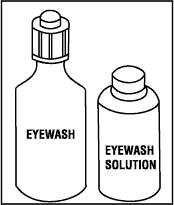
When should equipment be inspected and maintained?
Back to topOne person in the work area should be designated responsible for inspecting and operating (activating) the emergency shower, eyewash station, combination units, and drench hoses weekly. A weekly activation will help make sure that there is flushing fluid available, as well as clear the supply line of sediments and minimize microbial contamination caused by 'still' or sitting water. This person should keep a signed, dated record. The ANSI standard also recommends a complete inspection on an annual (yearly) basis.
Preventive maintenance inspections should check for such problems as valve leakage, clogged openings and lines, and adequacy of the fluid volume. A work record of these inspections should be kept. Replacement parts should be kept on hand to prevent the system from becoming non-functional. If the system breaks down for any reason, the workers in the area should be properly warned and protected.
Personal eyewash equipment should be inspected and maintained according to the manufacturer's instructions and thoroughly inspected at least annually for overall operation.
What type of training should the workers receive?
Back to topAll workers require instruction in the proper use and location of emergency showers or eyewash stations before any emergencies occur. It should never be assumed that workers are already aware of the proper procedures. Written instructions should be made available to all workers and posted beside the emergency shower and eyewash station. Part of the instructional process should include a "hands-on" drill on how to find equipment.
The wearing of contact lenses can be dangerous because products can become trapped under a contact lens. Any delays caused by removing contact lenses in order to rinse eyes could result in injury. Training should include instruction in contact lens removal.
In the event of an exposure, start flushing the eyes immediately and remove contact lenses as soon as possible. Do not delay flushing while trying to remove the contact lenses.
For more information, please see our OSH Answers: Contact Lenses at Work.
- Fact sheet last revised: 2024-03-15

